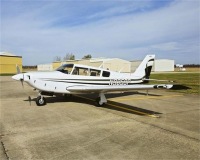AOA indicator
6 posts
• Page 1 of 1
AOA indicator
Has anyone installed an angle of attack indicator in their Comanche? I'm wondering which one you selected, where it is placed in the panel or where on the the glare shield, and what you think of it.
- Stephen Flaherty
- ICS member

- Posts: 54
- Joined: Sun Feb 08, 2004 2:58 am
- Location: Fayetteville, NC
Re: AOA indicator
I installed what was then callled a "Lift Reserve Indicator" about 25 years ago in a 3" top row instrument hole in the panel of my Twin Comanche. The LRI was developed by a man named Huntington and it was about $800 in that era's dollars! If you Google "lift reserve indicator" you will find lot of information, testimonials, etc. that fully describe the unit. About 12 years ago at Oshkosh I saw what was essentially the same unit but it had a 2" instrument and now was called an Angle of Attack indicator. I very much liked having the LRI in my airplane, but the location in the top row of instruments meant that on landings your eyes were jumping back and forth between the runway and the instrument panel. The smaller instrument could be mounted on the top of the glare shield and could be seen out of the corner of the eye while keeping an eye on the runway. I obtained the smaller instrument and I studied my panel for the higher location, and finally built a bracket that held the instrument with just the top half (that contains all the marks and the needle) projecting through the glare shield. The bracket held the instrument in the saddle between two top row 3" instruments. I like the looks of this installation much better than mounting the factory bracket that holds the entire instrument above the glare shield.
Currently I note there are many angle of attack indicators marketed that have colored electrical displays of the information. I personally prefer the simple unit I have that measures the two air pressures and directly moves the needle. It is very sensitive. I don't see the need to convert the air pressures to an electrical display. I do have the heated probe.
I think the angle of attack indicator is a great addition to any airplane. I would not own an airplane without one.
Al Powers PA30 C/R N88AP
Currently I note there are many angle of attack indicators marketed that have colored electrical displays of the information. I personally prefer the simple unit I have that measures the two air pressures and directly moves the needle. It is very sensitive. I don't see the need to convert the air pressures to an electrical display. I do have the heated probe.
I think the angle of attack indicator is a great addition to any airplane. I would not own an airplane without one.
Al Powers PA30 C/R N88AP
- SLIMDREDGER
- ICS member

- Posts: 306
- Joined: Sat Aug 05, 2000 6:20 pm
Re: AOA indicator
Stephen,
I installed a LRI last year (http://www.liftreserve.com) it was installed in front of the pilot on the glare shield. The price was $485 plus installation.
I installed a LRI last year (http://www.liftreserve.com) it was installed in front of the pilot on the glare shield. The price was $485 plus installation.
Andres
N9359P
N9359P
-

Andres Darvasi - Posts: 75
- Joined: Tue Feb 12, 2013 5:58 am
- Location: Mexico City, Mexico
Re: AOA indicator
Thanks for the info. Great intel. Its interesting that the new AOA indicators with the digital displays are priced around $2,000 and the LRI is at $900.
- Stephen Flaherty
- ICS member

- Posts: 54
- Joined: Sun Feb 08, 2004 2:58 am
- Location: Fayetteville, NC
Re: AOA indicator
When I Googled the web site they advertise the AofA at $550 with heat and $450 without. The website is not dated. Phone number 614 890 6301. ???
Looks like another proof that the Fed's Cost of Living Index is grossly incorrect.
AHP
Looks like another proof that the Fed's Cost of Living Index is grossly incorrect.
AHP
- SLIMDREDGER
- ICS member

- Posts: 306
- Joined: Sat Aug 05, 2000 6:20 pm
Re: AOA indicator
What I paid exactly a year ago, as mentioned in my original posting was $450.00 for an unheated one.
Andres
Andres
Andres
N9359P
N9359P
-

Andres Darvasi - Posts: 75
- Joined: Tue Feb 12, 2013 5:58 am
- Location: Mexico City, Mexico
6 posts
• Page 1 of 1
Return to Maintenance - General
Who is online
Users browsing this forum: No registered users and 4 guests
